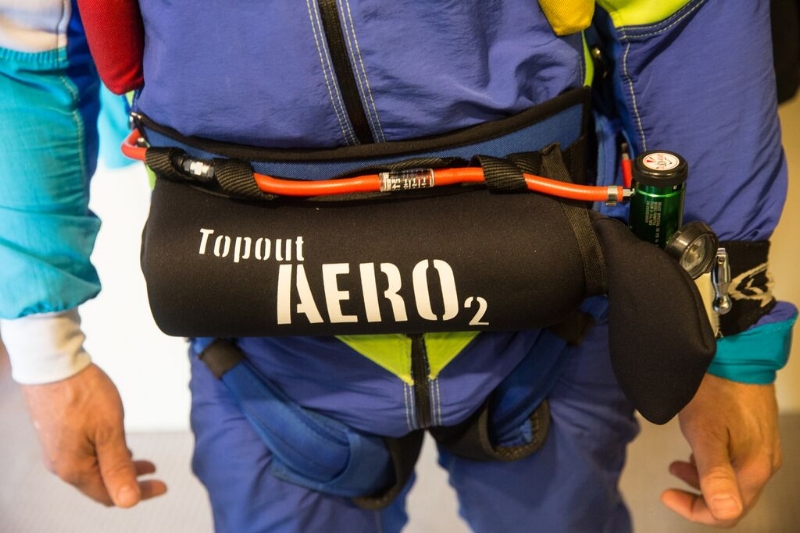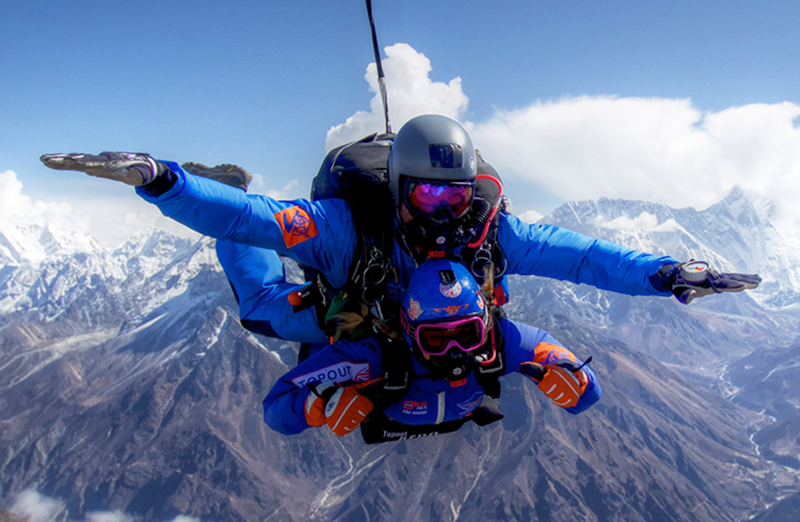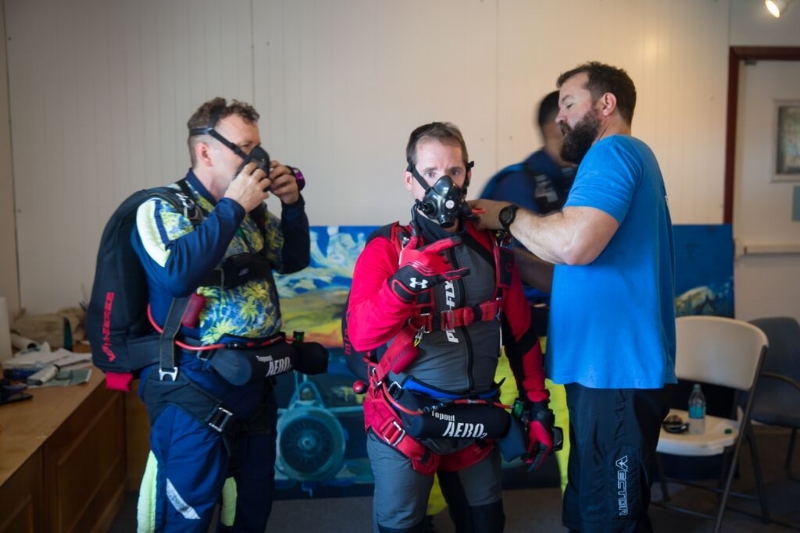Your HALO Skydiving Guide: HALO Parachute Jumping Explained

What to Know About HALO Jumps
Many people aren’t aware of how rich the skydiving culture is with its wide variety of traditions, disciplines, personalities, and unparalleled opportunities. The act of jumping out of an airplane is amazing on its own, and then there are plenty of ways to make it all the more exciting. Even licensed skydivers have a skydiving bucket list, and making a HALO skydive is a frequently found item pretty near the top! Why? Because HALO skydiving can be hard to come by, so the opportunity to do a HALO parachute jump is an exciting prospect.
What is a HALO parachute jump, you ask? HALO stands for High Altitude Low Opening, which means that the exit altitude for the skydive is much higher than the usual 13,500’, but that the skydivers still open their parachutes between the typical (and comparatively low) altitude of 3,000’ or 4,000’.
While Skydive Cross Keys isn’t currently offering HALO jumps, some skydiving centers do. So, let’s get into all the ins and outs of what it’s like performing a HALO jump, skydive-related science, and HALO jump vs. skydiving facts.
What is a HALO Jump in Skydiving?
Not all parachute jumps are created equal. Sure, any time you get to jump out of an airplane is amazing, but there are certain factors that make some jumps more memorable than others. Jump altitude, time in freefall, who you’re jumping with, and the location are all things that could make a skydive even more epic than it normally is. And that applies to tandem jumps, too!
The main difference between HALO jumps and skydiving normally is the altitude, which translates to freefall time. Simply put, the higher you exit the plane, the longer you can fall through the air. And isn’t the phenomenal feeling of freefall what we’re all here for, afterall?
One point of confusion around HALO jumps is the gray area between military and civilian skydiving. The military refers to all skydives that include any freefall as HALO jumps, since technically you are exiting higher than you are deploying your parachute. But sport and civilian skydivers know those as your regular day-to-day skydives.
Civilian HALO jump altitude can go as high as 30,000+ feet! In some cases, you can actually double your freefall time. That’s more time to enjoy the view, create sky-high formations, glide in your wingsuit, or just relish in that sweet sweet feeling of human flight. And, of course, more close ups of your best day ever to catch on video!
Bonus fact! There’s also a HAHO jump, which stands for High Altitude High Opening. This refers to exiting at a high altitude and deploying the parachute shortly after clearing the aircraft.
The Challenges of HALO Jumps
So, if HALO jumps are so amazing, why isn’t that how all jumps are conducted? Wouldn’t it be better to always exit higher? Theoretically, yes. But it’s a bit more complicated than that. There are several factors that go into making a HALO jump, and not all of them fit seamlessly with regular skydiving operations.
First of all, HALO jumps have a higher level of risk than your everyday skydive. The main concern with flying to higher altitudes is hypoxia. Hypoxia is a state in which oxygen is not available in sufficient amounts for your tissues to function adequately. This can result from inadequate oxygen delivery due to low blood supply or low oxygen content in the blood (hypoxemia).
To put it in layman’s terms: there’s less oxygen at higher altitudes. And if your brain isn’t getting enough oxygen, you can feel dizzy, confused, and even lose consciousness. Not symptoms that pair well with jumping out of an airplane! Because of this, HALO jumps require additional safety considerations and gear that isn’t easy to include on every single jump.
A HALO jump is also more costly to execute than a regular skydive. The extra altitude means extra fuel, and we all know that gas isn’t cheap! And then there’s the time. Doubling freefall doesn’t add that much time in the grand scheme of things, but flying the plane an extra 10,000 feet sure does. On top of that, most airplanes actually slow down the higher they climb. So, doing all jumps as HALO jumps would really cut down on the number of loads a dropzone could do in a day, which means less skydiving all around.
And then there’s the added cost of the safety gear …

Gear & Equipment
As far as skydiving gear is concerned, the pieces that are worn on the skydiver’s body stay the same regardless of the type of jump. The rig, parachute, altimeter, and helmet are all pieces of skydiving equipment that are consistent across every jump. But there’s additional safety equipment required when the altitude of the jump starts getting higher than normal.
In order to discuss the equipment needed to make a HALO jump, we must first understand the different altitude categories. According to the United States Parachute Association (USPA), jump altitudes are qualified as:
- Low Altitude: Below 15,000 feet MSL (Mean Sea Level)
- Intermediate Altitude: 15,000 feet – 20,000 feet MSL
- High Altitude: 20,000 feet – 40,000 feet MSL
- Extreme Altitude: Above 40,000 feet MSL
A typical skydive would fall under the low altitude classification. Anything above 15,000 feet would be considered some type of HALO jump, which means that, at the very least, there needs to be supplemental oxygen and oxygen masks or cannulas onboard the airplane.
With each category comes different rules and gear:
- Intermediate Altitude jumps require all participants to begin breathing oxygen from the onboard oxygen supply at 8,000 feet until exit. Once the jumpers are ready to leave the plane, they can disengage from the supplemental oxygen supply and exit the airplane door.
- All jumpers participating in High Altitude jumps must breathe 100% oxygen for 30 minutes prior to takeoff, and are required to continue breathing oxygen during the entire ride to altitude. These jumpers also carry bailout bottles with additional oxygen that are activated before exit.
- Extreme Altitude jumps are so rare and risky that there are no established procedures for these skydives. Regulations and safety plans are created for each individual jump as it happens.
And this is just what’s required for the jumpers! Pilots and people acting as oxygen monitors on board the airplane have additional gear and regulations that they are responsible for.
Training & Qualifications
The good news is that you don’t have to be a member of the Special Forces to participate in a HALO jump. Unsurprisingly, though, there are some certification requirements and extra training involved with making HALO jumps.
Again, USPA breaks the qualification requirements down by altitude classification:
- Low Altitude skydives can be performed by any licensed skydiver
- For Intermediate Altitude jumps, participants should hold at least a USPA B license and have made 100 jumps
- For High Altitude jumps, participants should:
- hold a USPA C license
- have made at least one jump from 15,000 feet MSL or below using the same functioning bailout oxygen system
- For Extreme Altitude jumps, participants should:
- hold a USPA D license
- have made at least two jumps from below 35,000 feet MSL using the same functioning bailout oxygen and pressure systems
Once you’ve met these base requirements, you can go on to train for the jump you are planning to make. Attending a briefing is extremely helpful for understanding spotting at higher altitudes, jumper group separation, and how to use the oxygen system. Communication is even more important on specialty jumps than it already is on a normal skydive, so having your head in the game before you’re up in the clouds is a must.

Some dropzones even offer tandem HALO skydiving experiences. They’re few and far between though, so it will likely require a “HALO skydiving near me” kind of search. When reviewing skydiving dropzones online, make sure you do your due diligence and research, research, research! When it comes to an extreme sport like ours, be sure you’re confident in the dropzone you choose. They should be legit operators, members of the United States Parachute Association, and have plenty of consistently excellent reviews on platforms like Google, Facebook and Yelp.
Want to experience the freedom of flight at our awesome altitude of 13,500 feet?! Come jump with us today! Blue skies!

